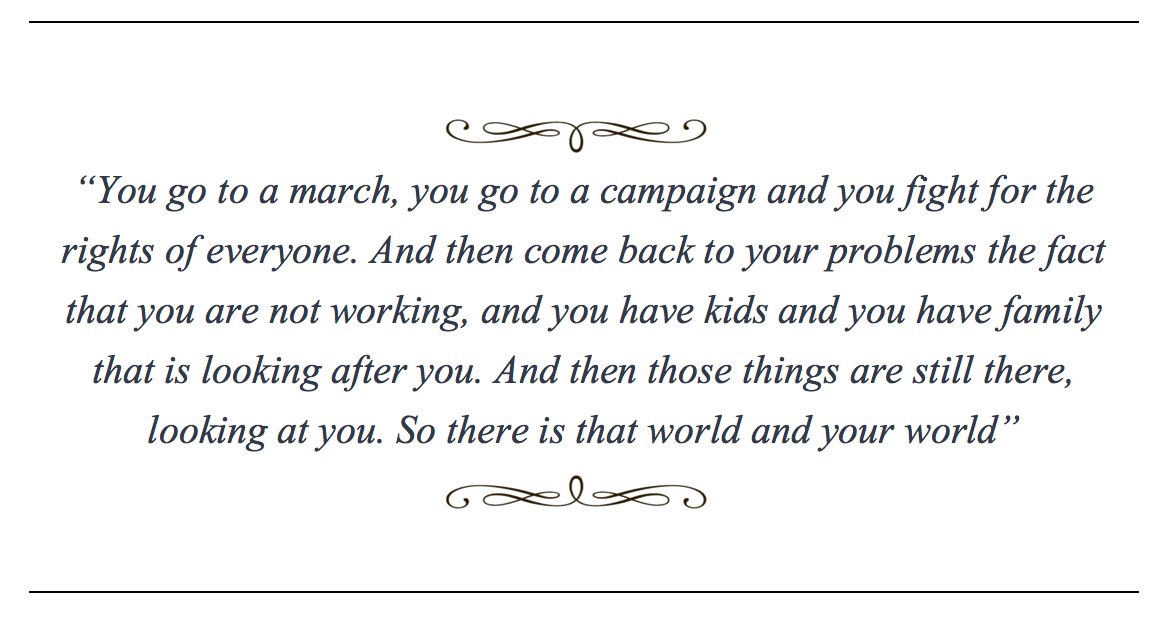With the Women’s March, and #MeToo drawing gender-based activism to the fore in the US and across the globe, how can we foster the desired personal and societal transformations that usher in the more equitable world we proclaim? The truth is even movements that are committed to gender equity can stifle the participation of women and nonbinary people on the basis of race, class, and sexuality, among other intersections of marginalization. They can be spaces of exclusion, physical and sexual violation, emotional coercion, isolation and alienation. Pathways to personal and societal transformation therefore merit our further deliberation. In 2010, I had the privilege of working with members of Remmoho, a group that was interrogating problematic gender dynamics within activist collectives in Johannesburg, South Africa. Their insights prove relevant for these challenges of building equitable, empowering and transformative activist practices.
Many Remmoho participants were active in a social movement that emerged in the early 2000s to contest neoliberal policies as these were taking hold in municipal and higher education governance. Remmoho also drew members from outside that movement. Problematic gender dynamics that spurred members’ activism included lack of representation in movement leadership. In reports, Remmoho noted how women constituted up to 90 percent of most mass meetings and marches, yet the predominance of their participation was hardly reflected in leadership. And activist meetings themselves were not welcoming spaces in many women’s views. In my interviews, a few women reported feeling physically intimidated in meetings. One was adamant in her refusal to attend another movement meeting. She described the one meeting she attended with another Remmoho member: “We were just sitting like this [arms crossed], we were sick and we were stressed because we’ve got something to say but we can’t. Those men they are bullies and they do whatever they think is right for them and as a woman, you don’t have a say in those meetings.” Others who felt comfortable speaking reported their contributions being derided and not being taken seriously. Such silencing and devaluation are not unique experiences but are rooted in patriarchal mindsets that remain pervasive in movements across the globe.

Beyond meetings themselves, participating in public demonstrations made even more evident the disconnection of many activist campaigns from the day-to-day lives of impoverished black women. As one activist expressed it: “You go to a march, you go to a campaign and you fight for the rights of everyone. And then come back to your problems the fact that you are not working, and you have kids and you have family that is looking after you. And then those things are still there, looking at you. So there is that world and your world” (in Eriksson 2007, 114).
Due to these frustrations, many women were skeptical of attempts at gender inclusion within their movement, since such attempts seemed only to reproduce women’s marginalization. They were not interested in “representational activism” (George 2007, 128), that is, where an elite group (in this case men in a patriarchal system) sought to represent the interests of disempowered women participants. They sought alternatives to these problematic patterns of interaction that alienated them from their activism. To address these concerns, women activists started meeting among themselves, eventually forming Remmoho.
Together with a number of key facilitators, Remmoho members worked to create sessions where participants could freely discuss their daily lives, encompassing and extending beyond their activism, including their familial relationships, sexuality, and living conditions. They staked their survival on these different terms. Sexuality was an important theme in discussions because it directly affected women’s mobility in the world. As one facilitator noted, “if I am in charge of my body, I can see freedom . . . that doesn’t mean that patriarchy won’t hit me, obviously, but I have tools to deal with it. In the opposite way, [if I am not in charge of my body,] I can have all the theory here but I won’t have the mobility to use it.” Nomvula, a founding member of Remmoho, noted the transformation that came with discussing sexuality:
the biggest concept that gave us a breakthrough was being the owners of our own bodies because we realized that as women we don’t own our bodies, we’re owned by the communities, we’re owned by children, we’re owned by mothers and sometimes by our in-laws… I think sexuality is key when you’re doing gender work because until someone knows how all these gender roles are actually constructed and what it means to me as an individual and as a woman in society you can’t really get a breakthrough.
Remmoho’s interventions were thus rooted in women’s bodily reclamation as fundamental to promoting gender parity. Activists noted that conceptual interventions would only achieve limited gains because it is easy for people to pay lip service to the cause of gender equality without fundamentally transforming their perspectives or behavior. Transformation had to first engage the breathing, embodied individual through felt and lived experiences. Whereas other sessions were predominantly concerned with whether or not participants understood concepts, Remmoho’s sessions were concerned with how the women were feeling. These workshops drew upon sensory techniques that involved ritual, food sculpture, dance, and other embodied practices.
Rituals created material manifestations of the women’s cognitive and emotional processes and encouraged extensive testimony about women’s experiences, including of poverty, sexual violence, physical abuse, and other daily struggles. These rituals revalorized items, such as food, that women came in contact with in their everyday lives. During a three-day workshop, for example, water — the privatization of which had been cause for deprivation — became a reclaimed agent representing the energetic contributions of participants in the workshop. The women introduced themselves at the beginning of the workshop, discussing how they were feeling. As they did so, they drank water, holding a cup and contributing their energy to the water in it. They then poured this water into a bowl. Others did the same. “To have that bowl, that is all our energy, it’s not water from the municipality, it’s ours,” a facilitator elaborated. Over the course of the workshop, whenever the women had new ideas or a change in their understanding, they contributed water to the bowl. Every morning, once the facilitator arrived with the bowl, the women repeated the process over the course of the day. At the end of the workshop, the women carried the bowl outside, singing. They then poured out the water over soil to nourish new growth: “All our energy and all our new understanding . . . maybe it’s touching another woman, and maybe it’s permitting flowers to grow. It’s the individual and at the same time it’s the collective,” the facilitator explained.

Another facilitator, a consultant with Gender at Work, contributed techniques focused on relaxation to Remmoho’s repertoire. She noted, “when people are more relaxed they can look deeper inside themselves” in order to honestly identify the sources of the challenges they face and propose sustainable solutions. Along these lines, Remmoho’s activities included overnight healing workshops and techniques from Capacitar, such as tai chi, acupressure, visualization, breathing work, and hand and head massage, as well as other wellness modalities.
Such seemingly minute actions proved impactful not just for generating personal transformations but also for collective participation. A founding member recalled in an interview how, in its early attempts to get women into leadership positions, Remmoho members would meet right before the broader movement’s meetings to encourage each other and through such encouragement generate a sense of capability such that more women began taking on leadership roles in their broader social movement.
Although Remmoho itself was not perfect, no coalition can be, its choices are instructive for this cultural moment. By highlighting the primacy of embodied knowledge (through ritual, testimony, and bodywork), Remmoho’s practices ushered in a modality of activism that centered on marginalized people, was validating of their experiences, and responsive to their needs. Following Remmoho, we need to develop practices that address more intimate sites of encounter, including how fellow comrades relate with one another, as well as the bodily and emotional significance of activism. We need to recognize the authority of those we have too often left behind, whose strivings matter as political interventions in themselves. Their interventions involve not only the voicing of what may otherwise be silenced or undervalued but also, through such voicing, disrupting patterns of alienation and cultivating transformative ways of being in the world.
To learn more about Remmoho, its members’ mobilization methodologies, and the backlash that ensued, check out my article in the current issue of Signs, “Awkward Activisms: Gender and Embodied Mobilization in a Postapartheid South African Social Movement.”
This essay originally appeared on Medium.













